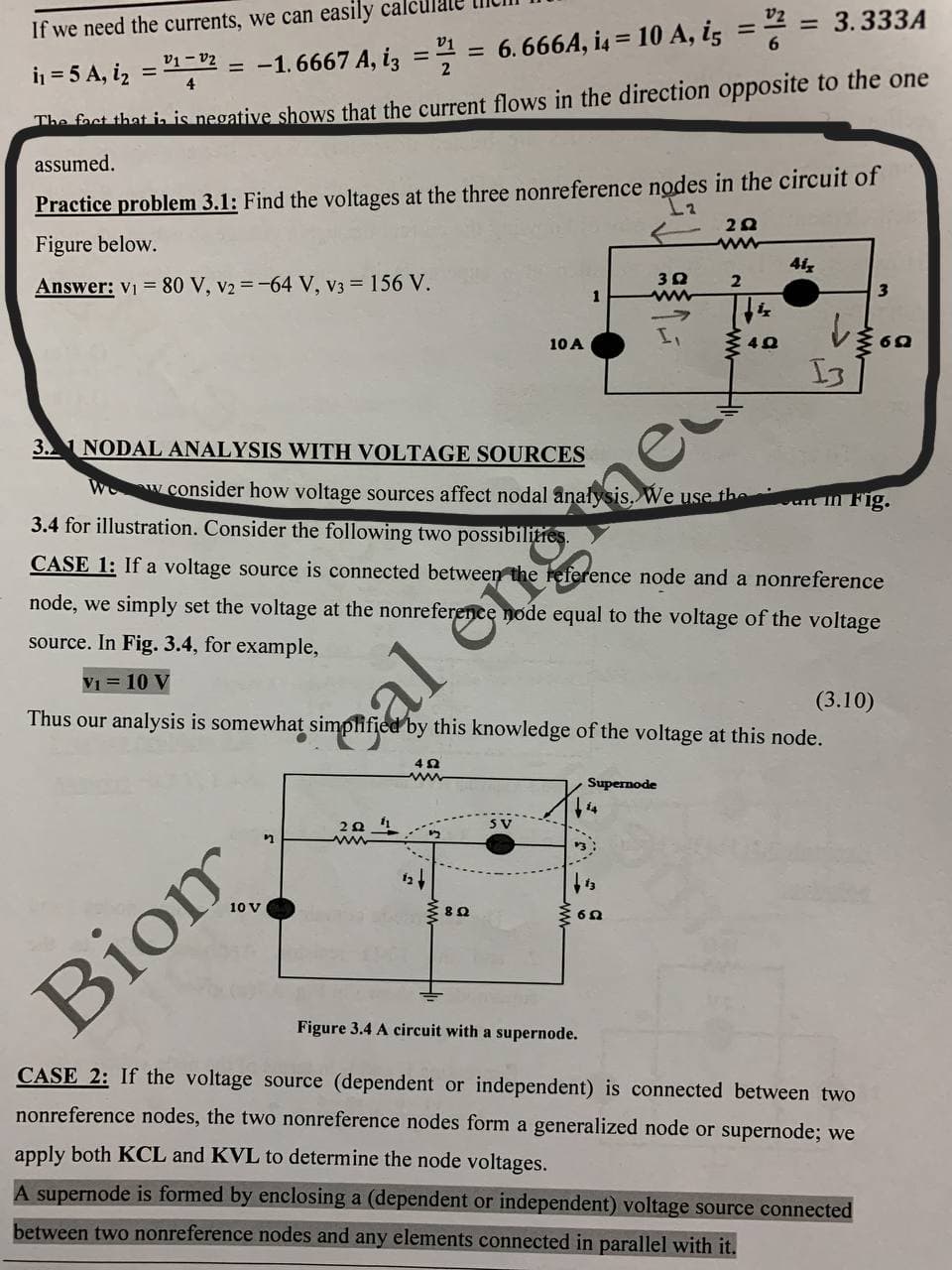Practice problem 3.1: Find the voltages at the three nonreference nodes in the circult Figure below. 41 Answer: Vi = 80 V, v2 =-64 V, v3 = 156 V. 1 し -> 10 A 40 I3 1 ww
Practice problem 3.1: Find the voltages at the three nonreference nodes in the circult Figure below. 41 Answer: Vi = 80 V, v2 =-64 V, v3 = 156 V. 1 し -> 10 A 40 I3 1 ww
Introductory Circuit Analysis (13th Edition)
13th Edition
ISBN:9780133923605
Author:Robert L. Boylestad
Publisher:Robert L. Boylestad
Chapter1: Introduction
Section: Chapter Questions
Problem 1P: Visit your local library (at school or home) and describe the extent to which it provides literature...
Related questions
Question

Transcribed Image Text:If we need the currents, we can easily cal
= 3.333A
i = 5 A, iz = 1-2 = -1.6667 A, iz =
6. 666A, i4 = 10 A, iz =2 =
%3D
%3D
The foct that ia is negative shows that the current flows in the direction opposite to the one
assumed.
Practice problem 3.1: Find the voltages at the three nonreference nodes in the circuit of
Figure below.
Answer: V1 = 80 V, v2 =-64 V, v3 = 156 V.
41,
2
1
10 A
I3
3. NODAL ANALYSIS WITH VOLTAGE SOURCES
W w. consider how voltage sources affect nodal analysis, We use the
3.4 for illustration. Consider the following two possibilities.
van n Fig.
CASE 1: If a voltage source is connected between the reference node and a nonreference
node, we simply set the voltage at the nonreference node equal to the voltage of the voltage
source. In Fig. 3.4, for example,
V1 = 10 V
(3.10)
Thus our analysis is somewhat simplified by this knowledge of the voltage at this node.
ạl engme
Supernode
10 V
Biom
Figure 3.4 A circuit with a supernode.
CASE 2: If the voltage source (dependent or independent) is connected between two
nonreference nodes, the two nonreference nodes form a generalized node or supernode; we
apply both KCL and KVL to determine the node voltages.
A supernode is formed by enclosing a (dependent or independent) voltage source connected
between two nonreference nodes and any elements connected in parallel with it.
ww.
Expert Solution
This question has been solved!
Explore an expertly crafted, step-by-step solution for a thorough understanding of key concepts.
Step by step
Solved in 2 steps with 1 images

Knowledge Booster
Learn more about
Need a deep-dive on the concept behind this application? Look no further. Learn more about this topic, electrical-engineering and related others by exploring similar questions and additional content below.Recommended textbooks for you

Introductory Circuit Analysis (13th Edition)
Electrical Engineering
ISBN:
9780133923605
Author:
Robert L. Boylestad
Publisher:
PEARSON

Delmar's Standard Textbook Of Electricity
Electrical Engineering
ISBN:
9781337900348
Author:
Stephen L. Herman
Publisher:
Cengage Learning

Programmable Logic Controllers
Electrical Engineering
ISBN:
9780073373843
Author:
Frank D. Petruzella
Publisher:
McGraw-Hill Education

Introductory Circuit Analysis (13th Edition)
Electrical Engineering
ISBN:
9780133923605
Author:
Robert L. Boylestad
Publisher:
PEARSON

Delmar's Standard Textbook Of Electricity
Electrical Engineering
ISBN:
9781337900348
Author:
Stephen L. Herman
Publisher:
Cengage Learning

Programmable Logic Controllers
Electrical Engineering
ISBN:
9780073373843
Author:
Frank D. Petruzella
Publisher:
McGraw-Hill Education

Fundamentals of Electric Circuits
Electrical Engineering
ISBN:
9780078028229
Author:
Charles K Alexander, Matthew Sadiku
Publisher:
McGraw-Hill Education

Electric Circuits. (11th Edition)
Electrical Engineering
ISBN:
9780134746968
Author:
James W. Nilsson, Susan Riedel
Publisher:
PEARSON

Engineering Electromagnetics
Electrical Engineering
ISBN:
9780078028151
Author:
Hayt, William H. (william Hart), Jr, BUCK, John A.
Publisher:
Mcgraw-hill Education,